
Article index
- 1 – Overview
- 2 – Gallery
- 3 – GPU information
- 4 – Benchmarks
- 4.1 – 3DMark FireStrike
- 4.2 – 3DMark TimeSpy
- 4.3 – 3DMark Port Royal
- 4.4 – 3DMark DX Raytracing Test
- 4.5 – 3DMark Intel XeSS Test
- 4.6 – 3DMark Speed Way
- 4.7 – Unigine Superposition
- 4.8 – FurMark
- 4.9 – Rhodium LC
- 5 – Burn-in Test
- 6 – Conclusion
1 – Overview
Few weeks ago, I tested the first Intel discrete GPU, the Arc A380. Today, here is a review of the Arc A750, one of the most powerful graphics card of the Arc Series. The Arc A750 Limited Edition is a card made by Intel (like the GeForce Founders Edition made by NVIDIA).
The Arc A750 is a graphics card powered by the DG2-512 GPU (Intel’s Xe HGP architecture — the DG2-512 GPU is also called ACM-G10). The A750 has 28 Xe cores and… Wait a minute, here is a way to convert Xe cores and Execution units (EUs) in regular shader cores like on NVIDIA and AMD GPUs:
– one Xe core = 16 EUs
– one EU = 8 ALUs
– one ALU = one shader core (or shading unit)
Then, the Arc A750 has 28 Xe cores, or 448 EUs or 3584 shader cores. The A750 GPU has 224 TMUs (texture management units) and 112 ROPs (render output units) and all data is stored in 8GB GDDR6 of video memory that communicates with the GPU via a 256-bit memory bus. The whole graphics card has a max power consumption of 225 Watts.
The Arc A750 LE has a neat and sleek VGA cooler, I like it. The cooling is done by 2 fans that work in hybrid mode: the cooler is in passive mode (fan speed: 0) for light workloads. For heavy graphics tasks, the fans spin and the noise is reasonable. No coil whine. The A750 has no LEDs lighting except the Intel ARC logo.
The A750 has a moderate price, especially if we compare it with recent NVIDIA RTX 40 Series… The MSRP (Manufacturer’s Suggested Retail Price) is USD $289 and here in France, we can find it for more or less 380 EUR.
Full specifications of the Arc A750 are available HERE. Arc A750 and A770 homepage can be found HERE.
2 – Gallery
The bundle is like the Edition: limited!
You have the box, the Arc A750 LE and a welcome card.
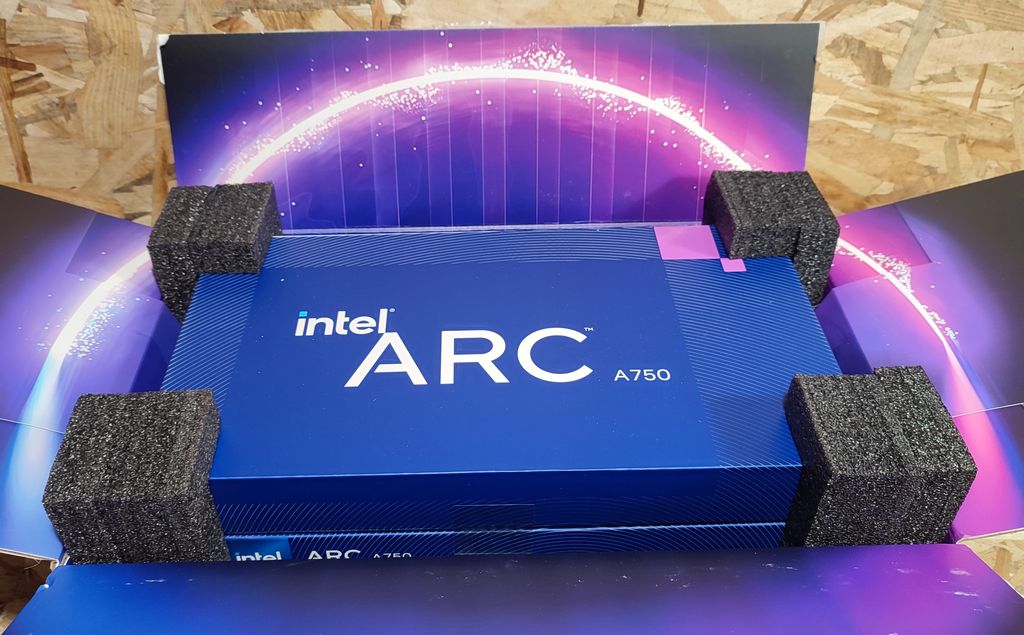
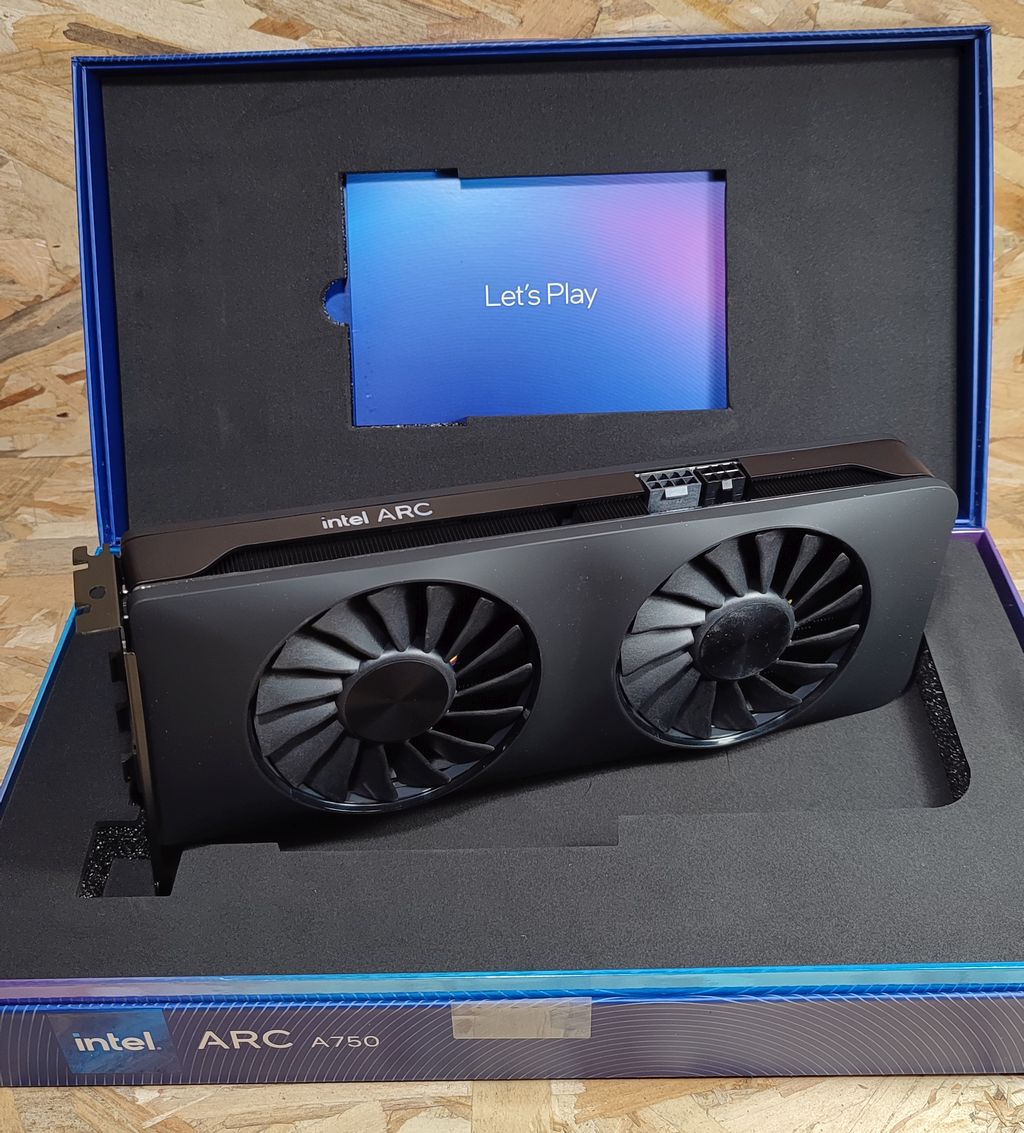
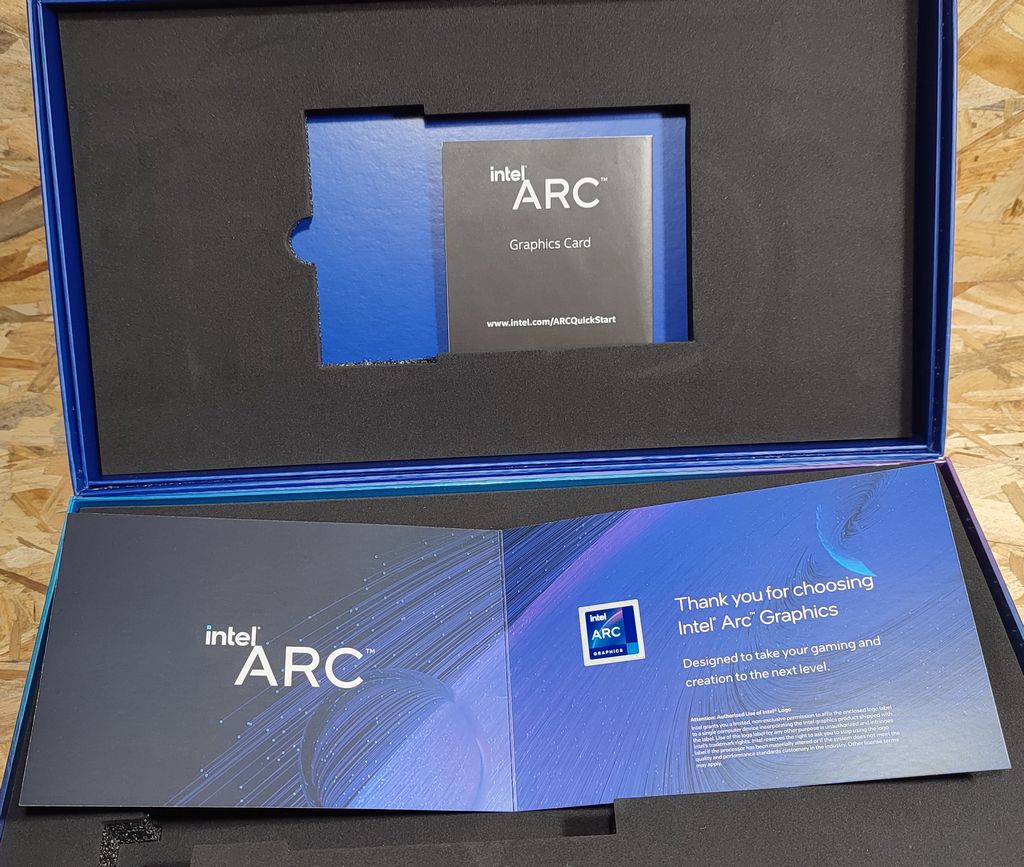
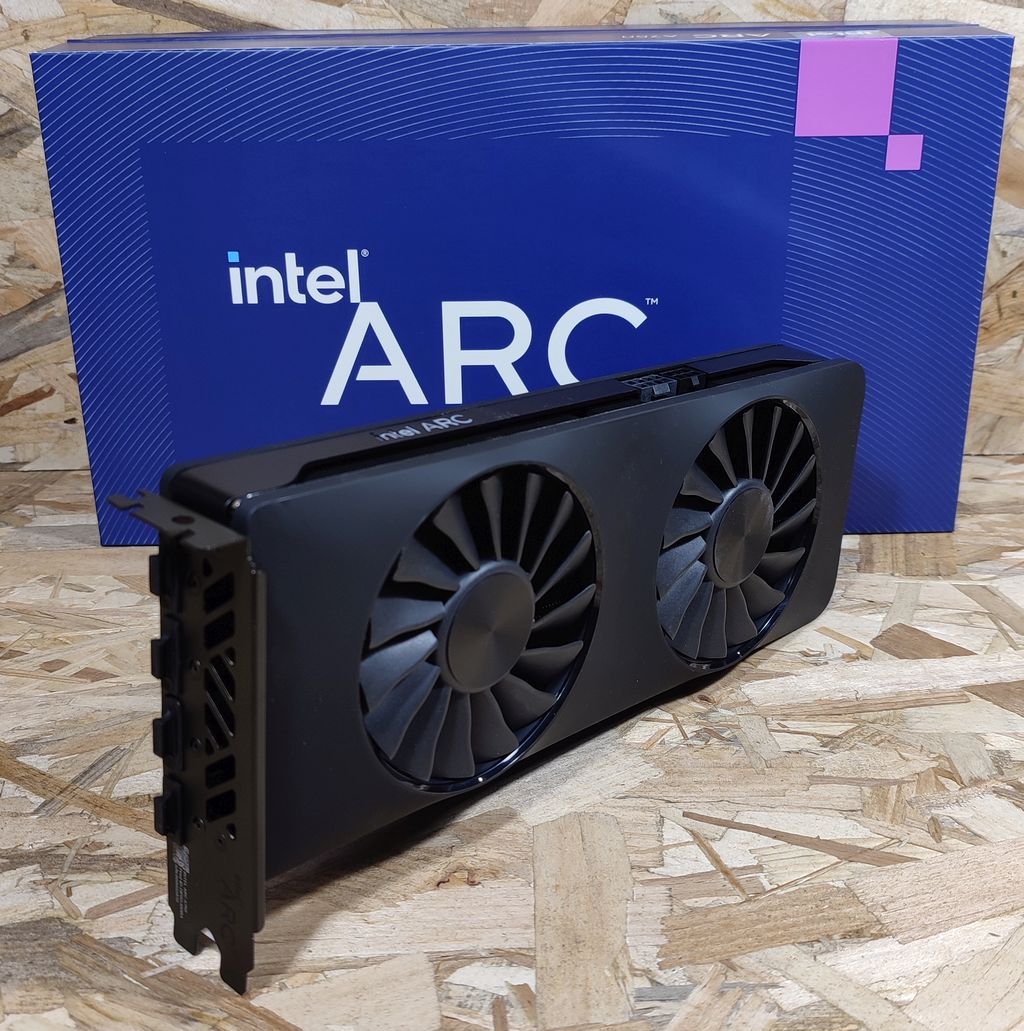
The illuminated logo:
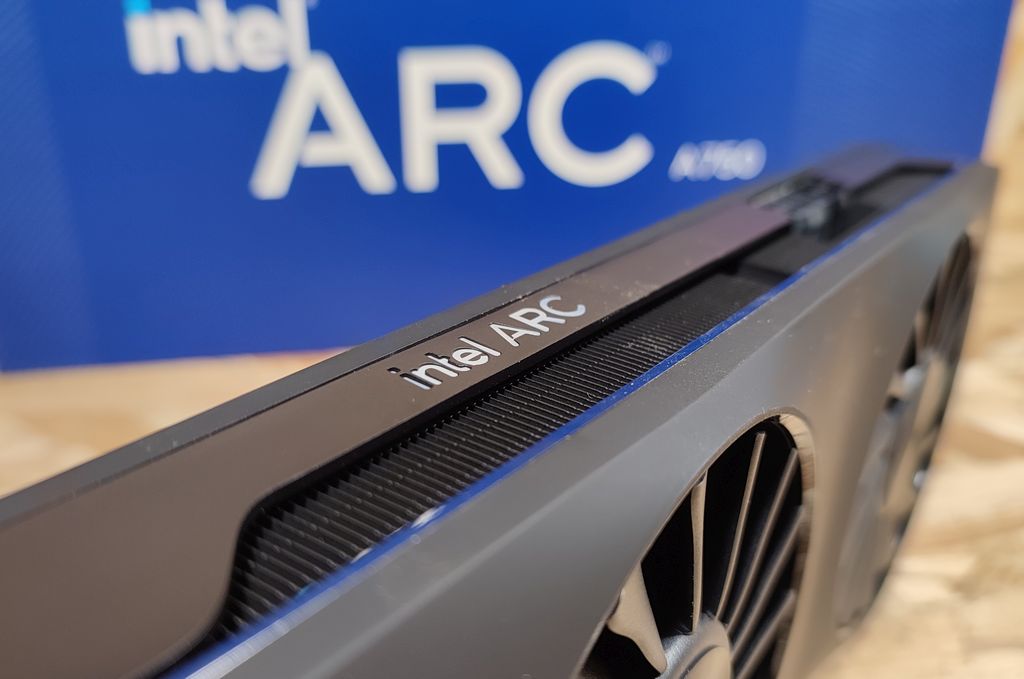
The Arc A750 requires one 8-pin + one 6-pin power connector:
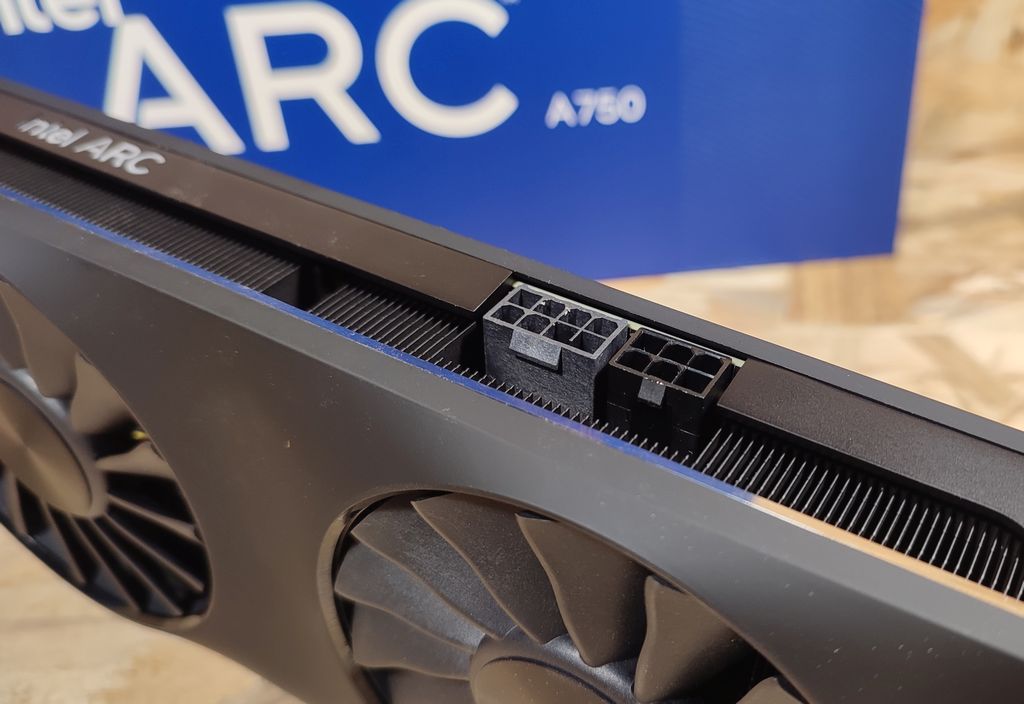
The rear side of the graphics card is covered by a plastic backplate.
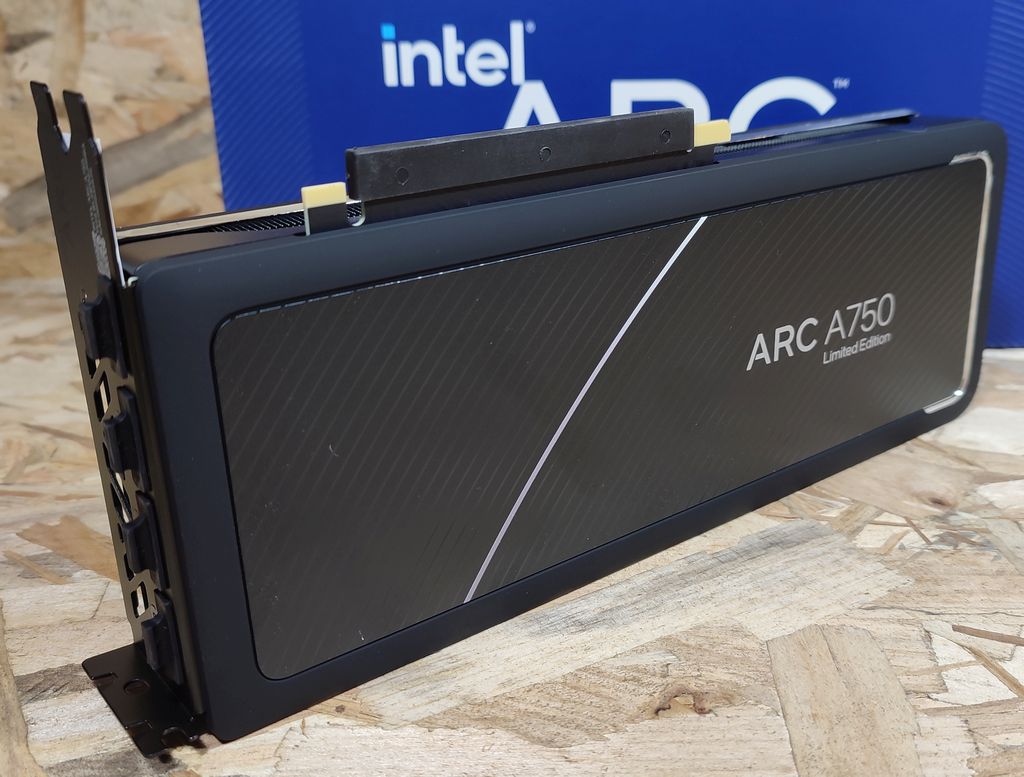
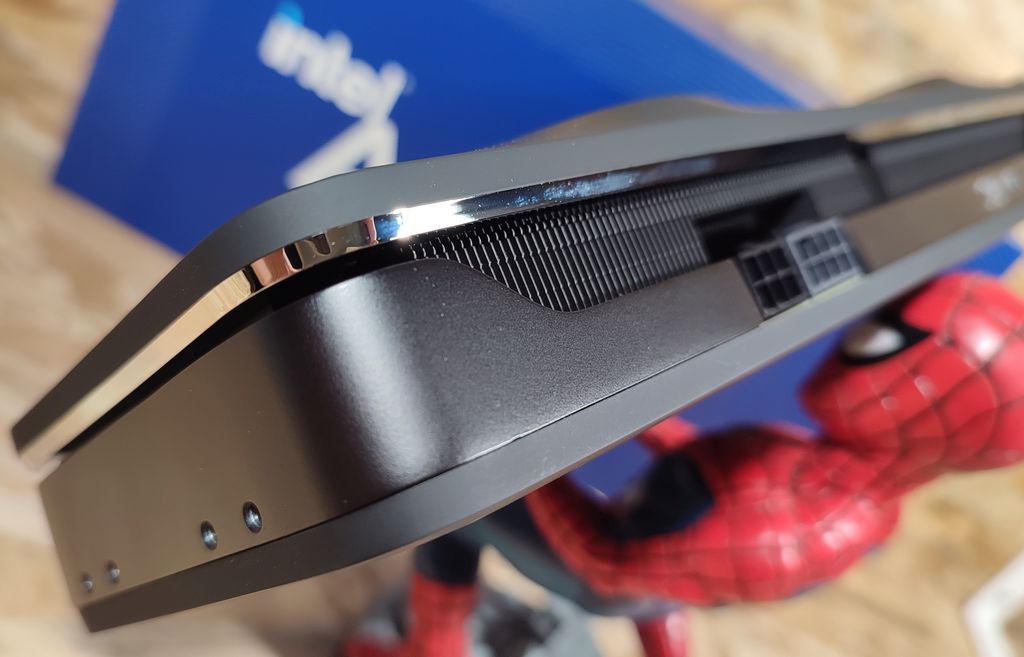
Output connectors: three DisplayPort 2.0 and one HDMI 2.1.
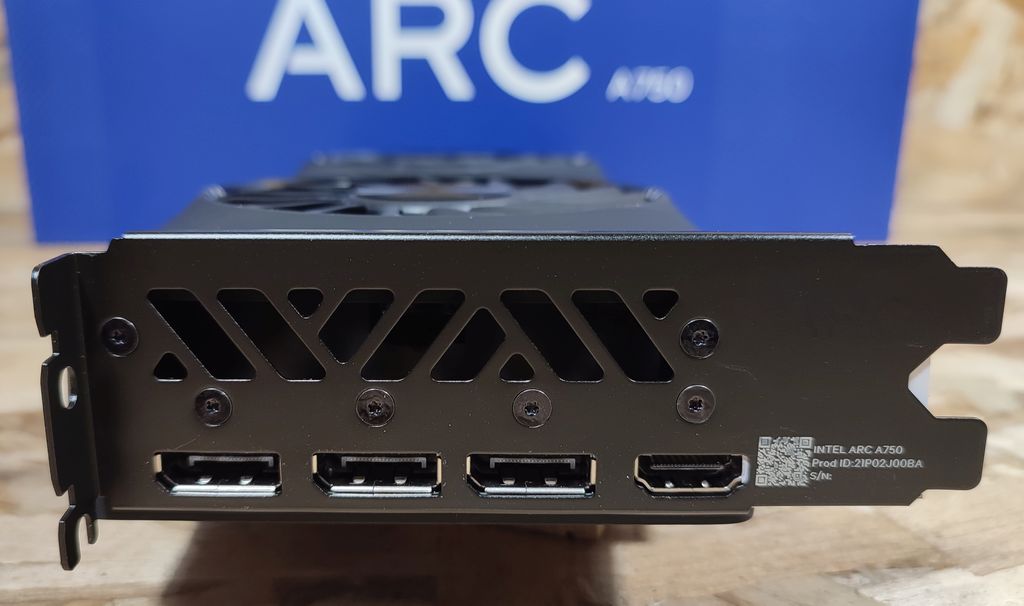
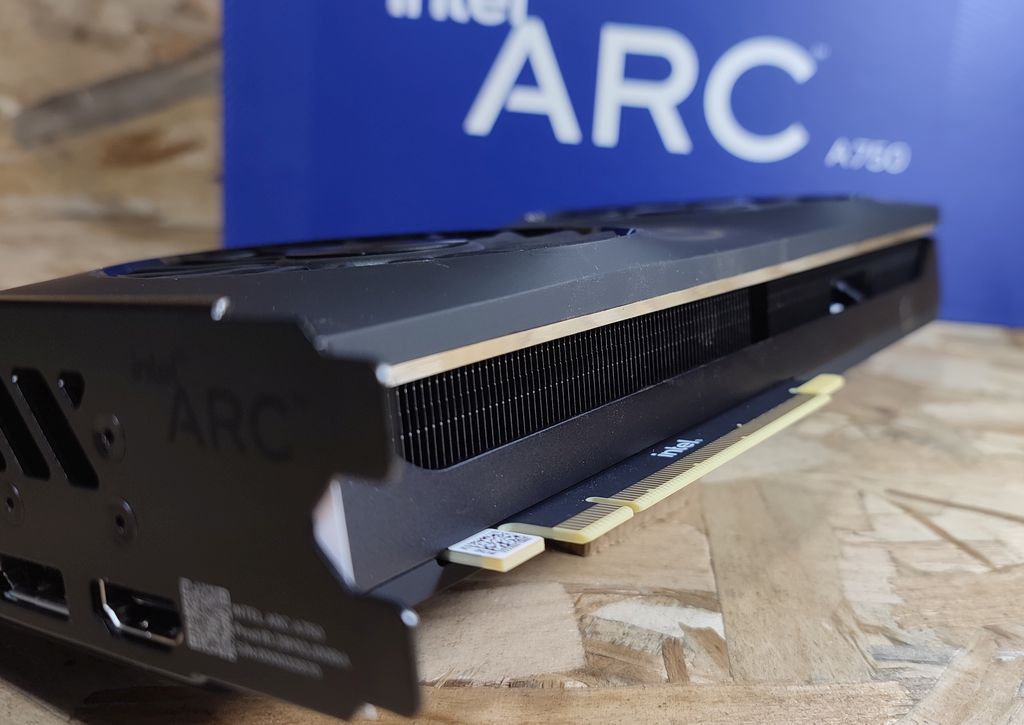
The different parts the of Arc A750/A770 LE (image from Intel):
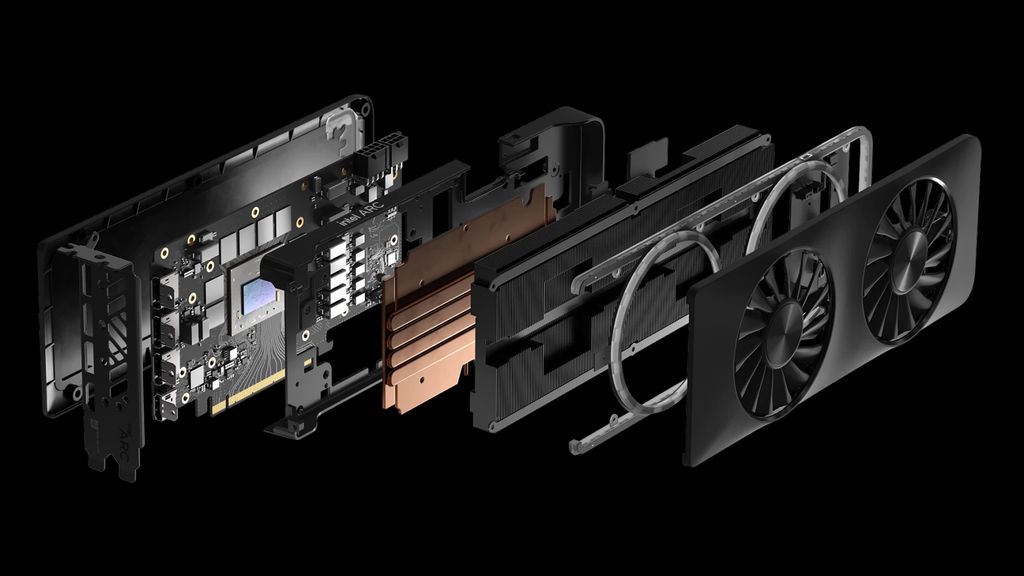
3 – GPU Information
GPU data from the new GPU Shark:
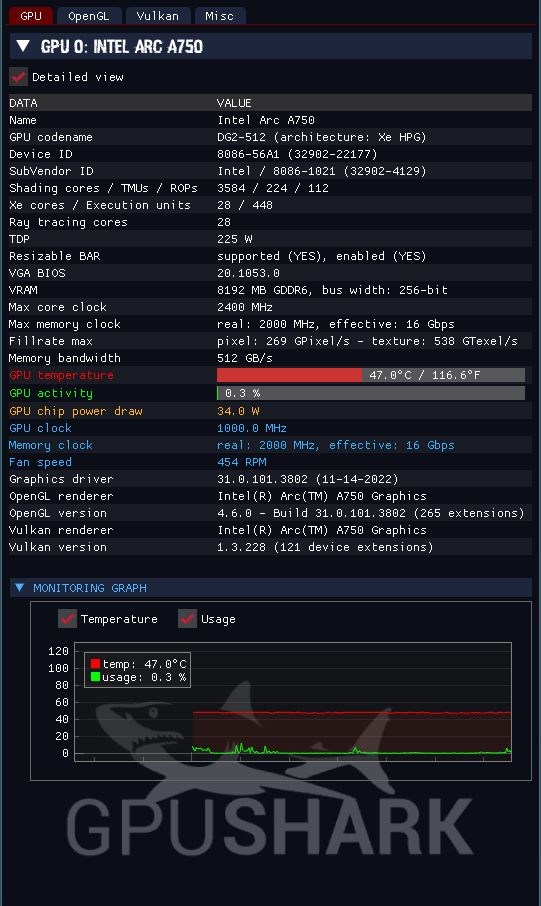
GPU-Z screenshots.

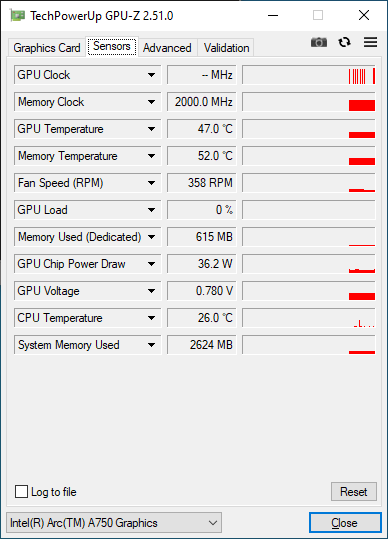
4 – GPU Benchmarks
| Arc A380 Test System 2 | |
|---|---|
| CPU | AMD Ryzen 7 5800X |
| Motherboard | ASUS TUF X570-Plus |
| Memory | 16GB DDR4 Corsair Vengeance LED @ 3200MHz |
| PSU | Corsair RM1000x |
| Storage | Samsung 860 EVO 1TB SSD |
| OS | Windows 10 22H2 64-bit |
| Graphics driver | Intel v31.0.101.3793 |
4.1 – 3DMark FireStrike
Fire Strike is a DirectX 11 benchmark for high-performance gaming PCs and overclocked systems. Fire Strike is very demanding, even for the latest graphics cards. If your frame rate is low, use Sky Diver instead.
Graphics test 1 has heavy tessellation and volumetric illumination. Graphics test 2 features complex smoke simulation using compute shaders on the GPU and dynamic particle illumination.
The Physics test runs 32 parallel simulations of soft and rigid body physics on the CPU.
The Combined test includes tessellation, illumination, smoke simulation and particles and post-processing on the GPU, while the CPU is tasked with running 32 parallel physics simulations.
Firestrike has a global score and three sub-scores (graphics, physics and combined). For this test, I compare the graphics score only.
| 48432 ASUS TUF Radeon RX 6800 XT OC 16GB – Adrenalin 20.12.2 |
| 31431 Intel Arc A750 LE – Intel 31.0.101.3793 – Resizable BAR: ON |
| 29130 GIGABYTE GeForce RTX 3060 Ti Gaming OC 8G – GeForce 460.79 |
| 13079 EVGA GeForce GTX 1060 SC 6GB – GeForce 416.94 |
| 11368 MSI GeForce GTX 970 – GeForce 416.94 |
| 9402 ASRock Arc A380 – Intel 31.0.101.3491 |
| 8616 MSI Radeon HD 7970 – Adrenalin 18.11.1 |
4.2 – 3DMark TimeSpy
Time Spy is a DirectX 12 benchmark with native support for new API features like asynchronous compute, explicit multi-adapter, and multi-threading.
Time Spy Graphics tests are rendered at 2560 × 1440 resolution.Graphics test 1 features lots of transparent content, particle shadows, and tessellation. Graphics test 2 features ray-marched volumetric illumination
with hundreds of lights and a large number of small particles.
Same thing, I took the graphics score only.
| 16294 ASUS TUF Radeon RX 6800 XT OC 16GB – Adrenalin 20.12.2 |
| 12264 Intel Arc A750 LE – Intel 31.0.101.3793 – Resizable BAR: ON |
| 10837 GIGABYTE GeForce RTX 3060 Ti Gaming OC 8G – GeForce 460.79 |
| 10415 ASUS ROG Strix GeForce RTX 2080 OC 8GB – GeForce 460.89 |
| 8461 MSI GeForce RTX 2070 Ventus 8GB – GeForce 417.01 |
| 4776 SAPPHIRE Radeon RX 5500 XT Pulse – Adrenalin 20.01.3 |
| 4334 ASRock Arc A380 – Intel 31.0.101.3491 – Resizable BAR: OFF |
| 4301 ASRock Arc A380 – Intel 31.0.101.3491 – Resizable BAR: ON |
| 4244 EVGA GeForce GTX 1060 SC 6GB – GeForce 416.94 |
| 753 Intel UHD Graphics 770 – Intel 31.0.101.1371 |
4.3 – 3DMark Port Royal
Port Royal is a graphics card benchmark for testing real-time ray tracing performance. To run this test, you must have a graphics card and drivers that support Microsoft DirectX Raytracing.
The test measures graphics card performance with a combination of real-time ray tracing and traditional rendering techniques. The scene features ray traced reflections, shadows (ray traced and shadow mapped), glass surfaces with ray traced reflections, volumetric lighting, particles, and post-processing effects. The rendering resolution is 2560 × 1440.
Even if the Arc A380 is an entry level card, it has hardware raytracing units and then can run 3DMark Port Royal!
| 9149 ASUS TUF Radeon RX 6800 XT OC 16GB – Adrenalin 20.12.2 |
| 6916 GIGABYTE GeForce RTX 3060 Ti Gaming OC 8G – GeForce 460.79 |
| 6512 Intel Arc A750 LE – Intel 31.0.101.3793 – Resizable BAR: ON |
| 6863 ASUS ROG Strix GeForce RTX 2080 OC 8GB – GeForce 460.89 |
| 745 ASRock Arc A380 – Intel 31.0.101.3491 – Resizable BAR: ON |
| 666 ASRock Arc A380 – Intel 31.0.101.3491 – Resizable BAR: OFF |
4.4 – 3DMark DX Raytracing Test
The DirectX Raytracing feature test measures pure ray-tracing performance. Use this test to compare the performance of dedicated ray-tracing hardware in the latest graphics cards.
In this feature test, there is a minimal amount of traditional rendering. The result of the test depends entirely on the ray-tracing performance of the graphics card.
Instead of using traditional rendering, the whole scene is ray-traced and drawn in one pass. Camera rays are traced across the field of view with small random offsets to simulate a depth of field effect. The frame rate is determined by the time taken to trace and shade a set number of samples for each
pixel (12 samples per pixel), combine the results with previous samples and present the output on the screen. The rendering resolution is 2560 × 1440.

| 28.78 FPS Intel Arc A750 LE – Intel 31.0.101.3793 – Resizable BAR: ON |
| 27.43 GIGABYTE GeForce RTX 3060 Ti Gaming OC 8G – GeForce 522.25 |
| 25.25 FPS ASUS TUF Radeon RX 6800 XT OC 16GB – Adrenalin 22.10.1 |
| 21.5 FPS ASUS ROG Strix GeForce RTX 2080 OC 8GB – GeForce 522.25 |
| 9 FPS ASRock Arc A380 – Intel 31.0.101.3491 |
4.5 – 3DMark Intel XeSS Test
XeSS (Xe Super Sampling) is an Intel graphics technology that uses AI-enhanced upscaling to improve performance while maintaining high image fidelity. XeSS renders each frame at a lower resolution to boost performance and then uses AI upscaling to generate frames at the target output resolution.
The test renders a scene two times to show the effect XeSS has on performance and image quality. The first run measures baseline performance by rendering the scene with temporal anti-aliasing (TAA) at the output resolution. The second run renders the scene at a lower resolution then uses the selected XeSS mode to upscale the frames to the output resolution.

| OFF: 39.6 FPS, ON: 52.4 FPS ASUS TUF Radeon RX 6800 XT OC 16GB – Adrenalin 22.10.1 |
| OFF: 27.3 FPS, ON: 41.2 FPS Intel Arc A750 LE – Intel 31.0.101.3793 – Resizable BAR: ON |
| OFF: 30.1 FPS, ON: 41.2 FPS GIGABYTE GeForce RTX 3060 Ti Gaming OC 8G – GeForce 522.25 |
| OFF: 2.2 FPS, ON: 12.7 FPS (+472%) ASRock Arc A380 – Intel 31.0.101.3491 – Resizable BAR: ON |
| OFF: 3.0 FPS, ON: 4.8 FPS (+62%) ASRock Arc A380 – Intel 31.0.101.3491 – Resizable BAR: OFF |
4.6 – 3DMark Speed Way
3DMark Speed Way is a graphics card benchmark for testing DirectX 12 Ultimate performance. To run this test, you must have a graphics card that supports DirectX 12 Ultimate and has 6GB or more of video memory.
Graphics test: the test measures graphics card performance with a combination of real-time ray tracing and traditional rendering techniques. The scene features ray traced reflections, real time global illumination, mesh shaders, volumetric lighting, particles and post-processing effects. The rendering resolution is 2560 × 1440.

| 3433 (avg FPS: 34) ASUS TUF Radeon RX 6800 XT OC 16GB – Adrenalin 22.10.1 |
| 2970 (avg FPS: 29) GIGABYTE GeForce RTX 3060 Ti Gaming OC 8G – GeForce 522.25 |
| 2320 (23.2 FPS) Intel Arc A750 LE – Intel 31.0.101.3793 – Resizable BAR: ON |
| 2168 (avg FPS: 21) ASUS ROG Strix GeForce RTX 2080 OC 8GB – GeForce 522.25 |
| 434 (avg FPS: 4) ASRock Arc A380 6GB – Resizable BAR: ON – Intel 31.0.101.3491 |
| 375 (avg FPS: 3) ASRock Arc A380 6GB – Resizable BAR: OFF – Intel 31.0.101.3491 |
4.7 – Unigine Superposition – 1080p Medium – Direct3D
| 21154 (avg FPS: 175) GIGABYTE GeForce RTX 3060 Ti Gaming OC 8G – GeForce 460.79 |
| 20985 (avg FPS: 157) ASUS TUF Radeon RX 6800 XT OC 16GB – Adrenalin 20.12.2 |
| 20923 (156 FPS) Intel Arc A750 LE – Intel 31.0.101.3793 – Resizable BAR: ON |
| 9082 (avg FPS: 67.9) EVGA GeForce GTX 1060 SC 6GB – GeForce 416.94 |
| 7166 (avg FPS: 53) ASRock Arc A380 – Intel 31.0.101.3491 – Resizable BAR: ON |
| 6141 (avg FPS: 46) ASRock Arc A380 – Intel 31.0.101.3491 – Resizable BAR: OFF |
4.8 – FurMark 1.31
FurMark is a very intensive graphics benchmark and does not depend on the processing power of the CPU. So FurMark is a quick way to have an overview of the graphics performances of a GPU.
P1080 (1920×1080)
| 17507 (avg FPS: 292) ASUS TUF Radeon RX 6800 XT OC 16GB – Adrenalin 20.12.2 |
| 10530 (avg FPS: 175) GIGABYTE GeForce RTX 3060 Ti Gaming OC 8G – GeForce 460.79 |
| 10137 (169 FPS) Intel Arc A750 LE – Intel 31.0.101.3793 – Resizable BAR: ON |
| 7322 (avg FPS: 122) ASUS ROG Strix GeForce GTX 1080 OC 8GB – GeForce 416.94 |
| 4556 (avg FPS: 76) EVGA GeForce GTX 1060 SC 6GB – GeForce 416.94 |
| 4475 (avg FPS: 75) SAPPHIRE Radeon RX 5500 XT Pulse – Adrenalin 20.01.3 |
| 3246 (avg FPS: 54) MSI Radeon HD 7970 – Adrenalin 18.11.1 |
| 3036 (avg FPS: 50) ASRock Arc A380 – Intel 31.0.101.3491 – Resizable BAR: ON |
| 2969 (avg FPS: 49) ASRock Arc A380 – Intel 31.0.101.3491 – Resizable BAR: OFF |
| 714 (avg FPS: 12) Intel UHD Graphics 770 – Intel 31.0.101.1371 |
4.9 – Rhodium LC
Rhodium LC (LC for Liquid Carbon!) is a new GPU pixel shader benchmark made with GeeXLab and based on this shadertoy demo. You can download RhodiumLC from THIS PAGE.

P1080 (1920×1080)
| 6189 (103 FPS) Intel Arc A750 LE – Intel 31.0.101.3793 – Resizable BAR: ON |
| 5740 (avg FPS: 95) ASUS TUF Radeon RX 6800 XT OC 16GB – Adrenalin 20.12.2 |
| 4853 (avg FPS: 80) ASUS ROG Strix GeForce RTX 2080 OC 8GB – GeForce 416.94 |
| 4094 (avg FPS: 68) GIGABYTE GeForce RTX 3060 Ti Gaming OC 8G – GeForce 526.98 |
| 2835 (avg FPS: 47) EVGA GeForce GTX 1070 FTW – GeForce 416.94 |
| 2773 (avg FPS: 46) ASUS Strix Radeon RX 5700 – Adrenalin 20.12.2 |
| 1923 (avg FPS: 32) EVGA GeForce GTX 1060 SC 6GB – GeForce 416.94 |
| 1755 (avg FPS: 29) SAPPHIRE Radeon RX 5500 XT Pulse – Adrenalin 20.01.3 |
| 1719 (avg FPS: 28) ASRock Arc A380 – Intel 31.0.101.3491 |
| 1484 (avg FPS: 24) MSI GeForce GTX 970 – GeForce 416.94 |
| 1192 (avg FPS: 19) MSI Radeon RX 470 8GB – Adrenalin 18.11.1 |
| 303 (avg FPS: 5) Intel UHD Graphics 770 – Intel 31.0.101.1371 |
Whow!?… The Arc A750 dominates this graphics test… faster than the RTX 3060 Ti, even faster than the RX 6800 XT! This is a surprise!
5 – Burn-in Test
The burn-in test has been done with the new version of FurMark (that will be released shortly). This version of FurMark is 64-bit and uses OpenGL or Vulkan API. The FurMark Vulkan version produced best results (higher temperature and power consumption) with the Arc A750.
In Arc control center you can tune some parameters like the GPU Power Limit. By default, the GPU Power Limit is set to 190W. I did two tests: the first one with power limit set to
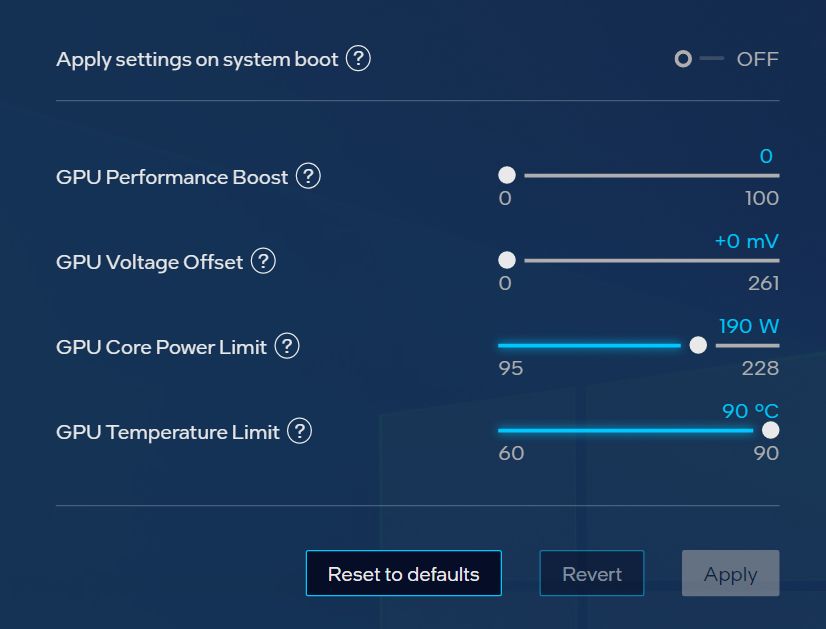
Idle state
– total power consumption of the testbed: 76W
– GPU temperature: 47°C
– GPU chip power draw: 42W
Stress test 1 – GPU Core Power limit: 190W
– total power consumption of the testbed: 309W
– GPU temperature: 75°C
– GPU chip power draw: 190W
Stress test 2 – GPU Core Power limit: 228W
– total power consumption of the testbed: 369W
– GPU temperature: 82°C
– GPU chip power draw: 225W
VGA cooler: under full graphics load, fans are audible but the noise is very limited and acceptable. In a closed case, the noise will be barely audible.

6 – Conclusion
Honestly, this card is a nice surprise for me. The performances of the Arc A750 are very close to the GeForce RTX 3060 Ti and in some tests, the A750 is ahead of the RTX 3060 Ti. The very nice result comes from the RhodiumLC pure pixel shader test: the Arc A750 is faster than both the RTX 3060 Ti and the Radeon RX 6800 XT. I have to confirm this score with other pixel shader tests in the upcoming weeks. The Arc A750 is also the fastest GPU in the 3DMark DX ray tracing test.
I also tested just for fun, my first ray tracing test. The demo works fine with the Arc A750 (this result is important because the ray tracing test is based on a 2-year old Vulkan code and A750
drivers seems to accept it).

The Arc A750 is a mid range range card available at a reasonable price. Intel is a old actor in the integrated GPU world but is new in the realm of discrete graphics cards. That means the graphics drivers are not mature. I didn’t notice important bugs.
UPDATE (2022.12.03)
The VRAM amount display bug in Unigine Superposition was related to the version of Superposition: 1.0. The bug is fixed in Superposition 1.1:
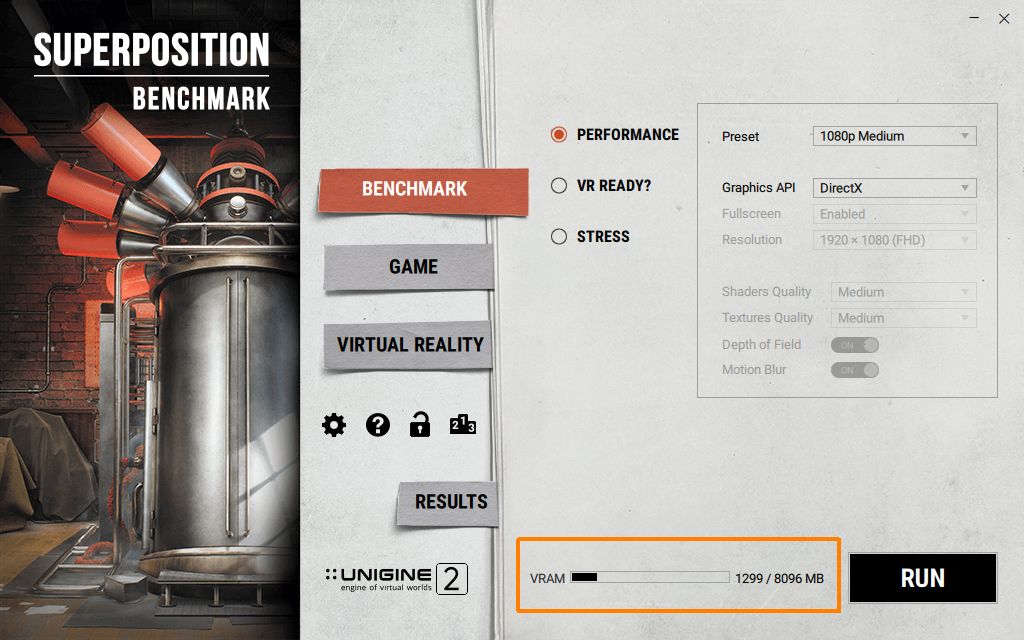
The only bug I saw is related to the VRAM amount in Unigine Superposition. The benchmark detected only 1024MB of VRAM for Arc A750:
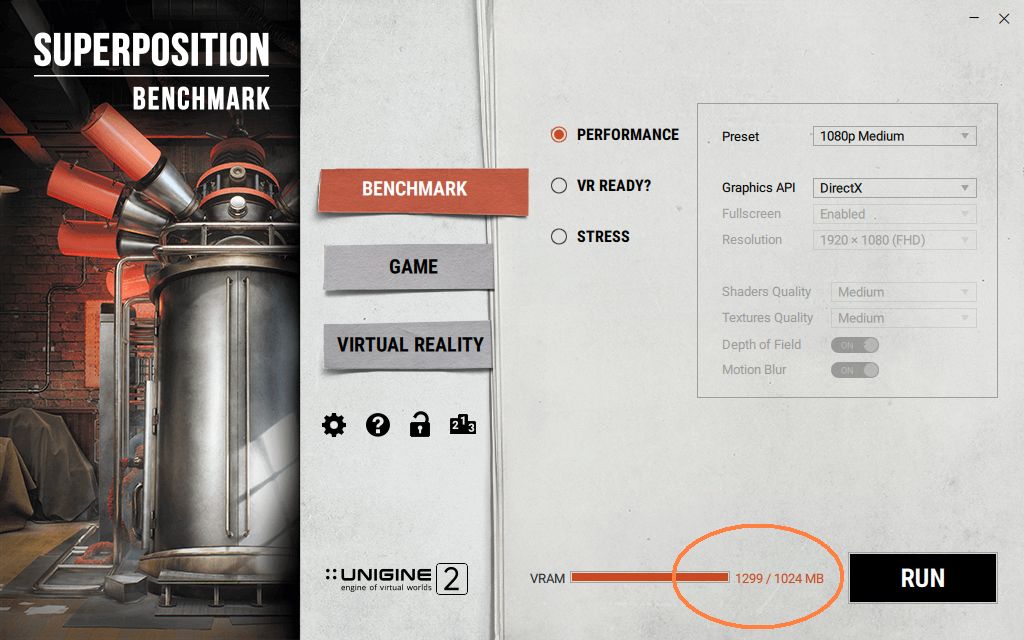
But the benchmark worked flawlessly.
The only issue for me is the GPU chip power draw at idle that is a bit important: more than 40W. If I look at my GeForce RTX 2070, the chip power draw is only 5W at idle. I hope its a driver bug, because 40W is important nowadays, especially if the system runs 10 hours or more a day. Even if I didn’t notice drivers bugs, there are bugs and unoptimized sections in current Arc drivers. It’s normal for a new driver! But it’s not a real problem, I’m sure that most of the issues will be fixed in the next updates of the graphics driver.
The Arc A380 is a entry level card. The Arc A750 is, this time, a serious graphics card. It offers good performances, supports recent 3D APIs including advanced features like hardware ray tracing and and is available at a correct price. The Arc A750 is a nice alternative to the GeForce RTX 3060 or 3060 Ti if you don’t need CUDA acceleration.
Great job Intel!
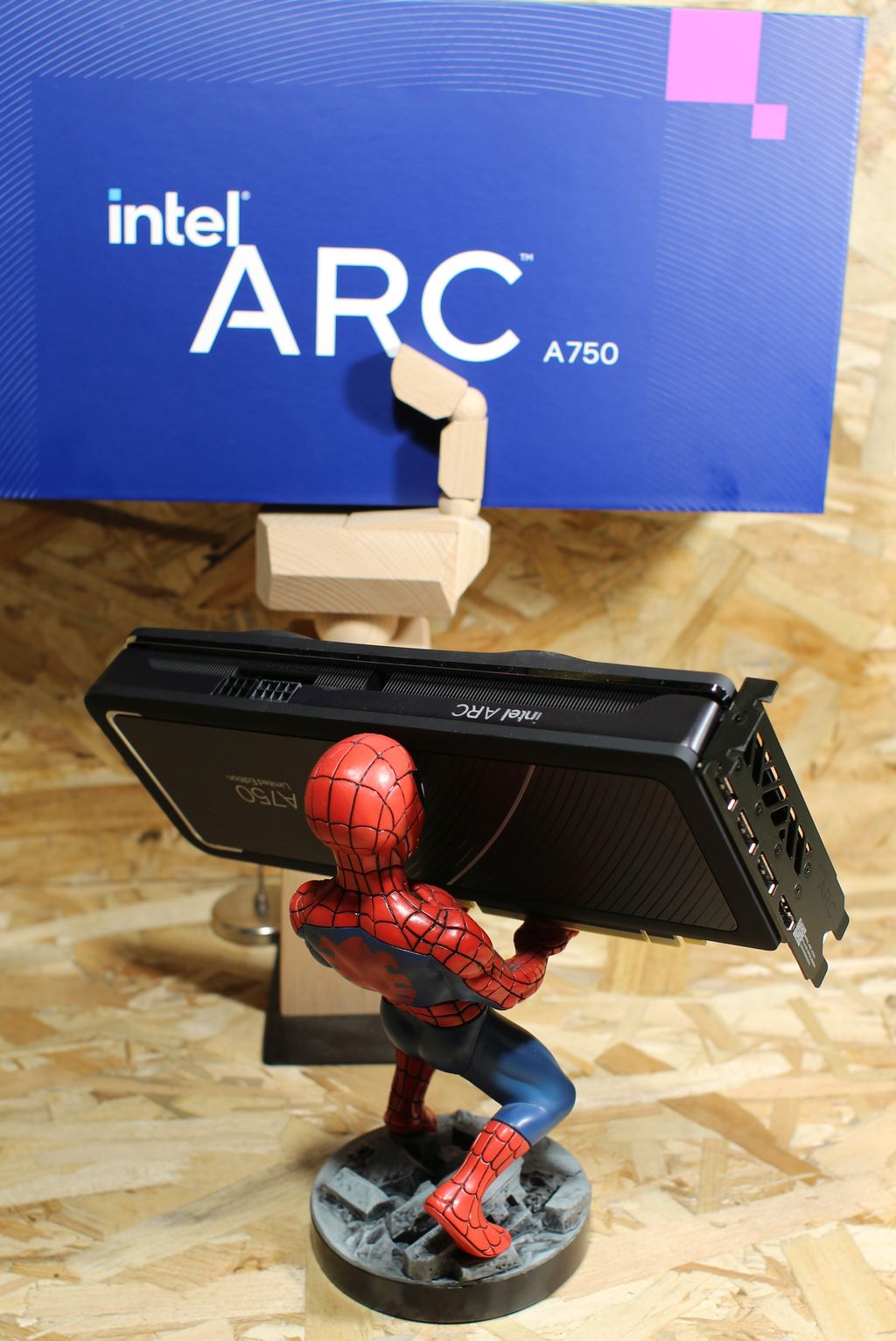
UPDATE (2022.11.30)
I’m updating MSI Kombustor and it looks like the Arc graphics driver (v101.3802) has a bug in the texture coordinates in this particular demo (msi-01):
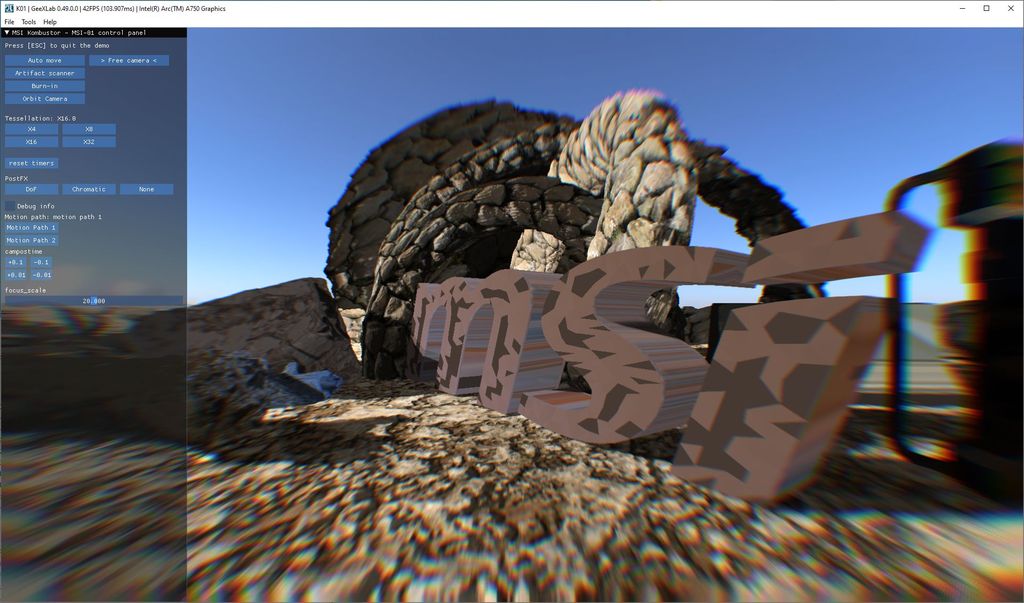
For reference, here is the right rendering (on GeForce or Radeon GPUs):
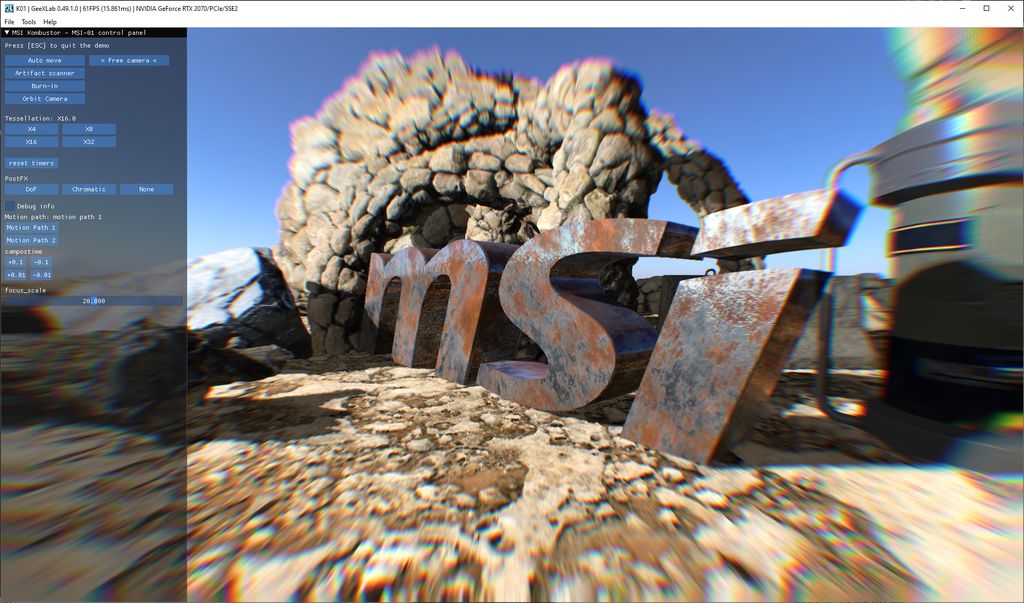
I hope Intel graphics driver team will fix this bug!